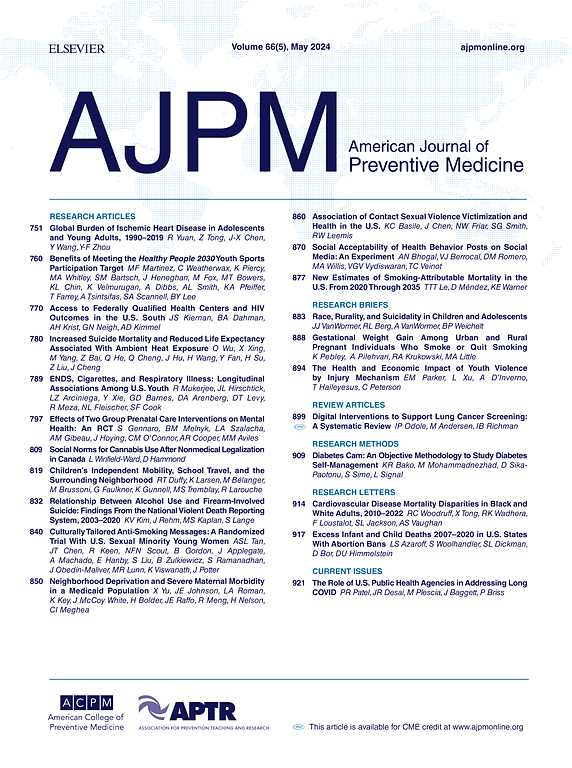Changes in Price, Consumption, Prevalence, and State Revenue of Transitioning Cigarette Sales to State-Controlled Outlets
IF 4.5
2区 医学
Q1 MEDICINE, GENERAL & INTERNAL
引用次数: 0
Abstract
Introduction
Policies that phase out the retail sale of tobacco products have been recommended to accelerate the tobacco endgame and reach negligible tobacco use rates. Using simulation modeling, this study assessed how a policy that transitions cigarette sales to state-controlled outlets may change prices and thus affect state revenue, cigarette pack sales, and smoking prevalence.
Methods
Using data from the Behavioral Risk Factor Surveillance System and Tax Burden On Tobacco, models were developed to examine 3 potential scenarios resulting from a policy that transitions the sales of cigarette products to state-controlled outlets in Oregon, Pennsylvania, Vermont, and Virginia. In Model 1, each state would keep cigarette pack prices at their current retail price but retain markup; in Model 2, cigarette pack prices would increase by 7%; and in Model 3, each state would increase prices to meet a consumption target reduction of 5%. For each price scenario, additional models that also considered changes to consumer travel and time costs were run.
Results
Across all models, state revenue increased in each state. Results suggest that the policy would increase revenue by at least 16% in Oregon to 302% in Virginia. In models that assumed that the cigarette pack price would increase, cigarette pack consumption and smoking prevalence declined. Declines in pack consumption and smoking prevalence ranged from 1% to 5% across states. Findings were robust to different assumptions about total own-price elasticities in sensitivity analyses.
Conclusions
Transitioning cigarette sales to state-controlled outlets may increase state revenue while reducing cigarette consumption and smoking prevalence.
烟草销售向国有销售点过渡的价格、消费、流行和国家收入变化。
导言:建议采取逐步停止零售烟草制品的政策,以加速烟草的终结并使烟草使用率达到可忽略不计的水平。利用模拟模型,本研究评估了将香烟销售转移到国家控制的商店的政策如何改变价格,从而影响国家收入、香烟包装销售和吸烟率。方法:利用来自行为风险因素监测系统和烟草税收负担的数据,开发了模型,以检查俄勒冈州,宾夕法尼亚州,佛蒙特州和弗吉尼亚州将卷烟产品销售转移到国家控制的销售点的政策所导致的三种潜在情景。在模型1中,每个州将香烟包装价格保持在当前零售价格,但保留加价;在模型2中,香烟包装价格将上涨7%;在模型3中,每个州都将提高价格以达到减少5%的消费目标。对于每个价格场景,还运行了考虑消费者旅行和时间成本变化的附加模型。结果:在所有模型中,各州的收入都有所增加。结果显示,该政策将使俄勒冈州的收入增加至少16%,弗吉尼亚州的收入增加302%。在假设烟盒价格上涨的模型中,烟盒消费量和吸烟率下降。各州的包装消费和吸烟率下降幅度从1%到5%不等。研究结果对敏感性分析中关于总自有价格弹性的不同假设是稳健的。结论:将卷烟销售过渡到国家控制的网点可以增加国家收入,同时降低卷烟消费和吸烟率。
本文章由计算机程序翻译,如有差异,请以英文原文为准。
求助全文
约1分钟内获得全文
求助全文
来源期刊

American Journal of Preventive Medicine
医学-公共卫生、环境卫生与职业卫生
CiteScore
8.60
自引率
1.80%
发文量
395
审稿时长
32 days
期刊介绍:
The American Journal of Preventive Medicine is the official journal of the American College of Preventive Medicine and the Association for Prevention Teaching and Research. It publishes articles in the areas of prevention research, teaching, practice and policy. Original research is published on interventions aimed at the prevention of chronic and acute disease and the promotion of individual and community health.
Of particular emphasis are papers that address the primary and secondary prevention of important clinical, behavioral and public health issues such as injury and violence, infectious disease, women''s health, smoking, sedentary behaviors and physical activity, nutrition, diabetes, obesity, and substance use disorders. Papers also address educational initiatives aimed at improving the ability of health professionals to provide effective clinical prevention and public health services. Papers on health services research pertinent to prevention and public health are also published. The journal also publishes official policy statements from the two co-sponsoring organizations, review articles, media reviews, and editorials. Finally, the journal periodically publishes supplements and special theme issues devoted to areas of current interest to the prevention community.
 求助内容:
求助内容: 应助结果提醒方式:
应助结果提醒方式:


